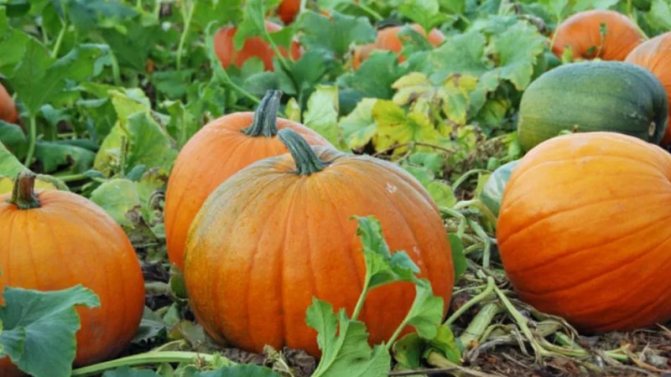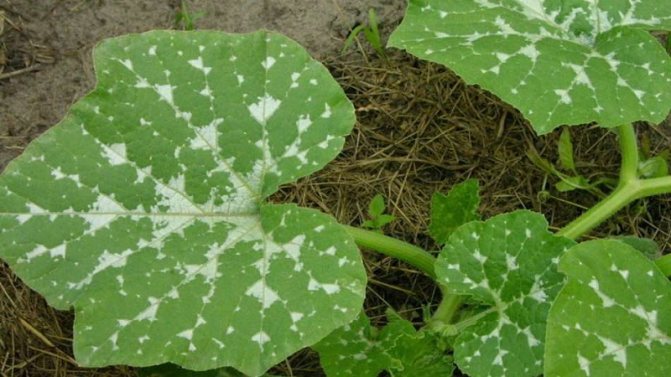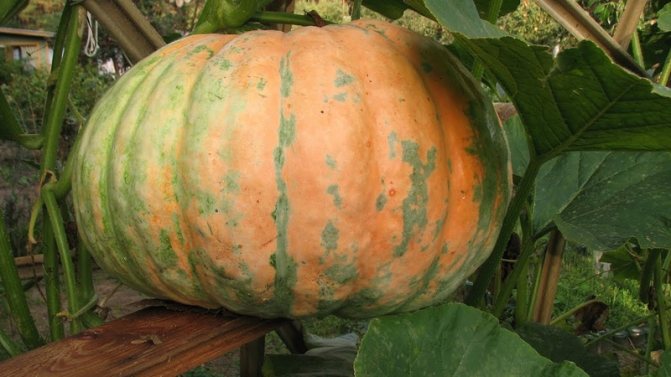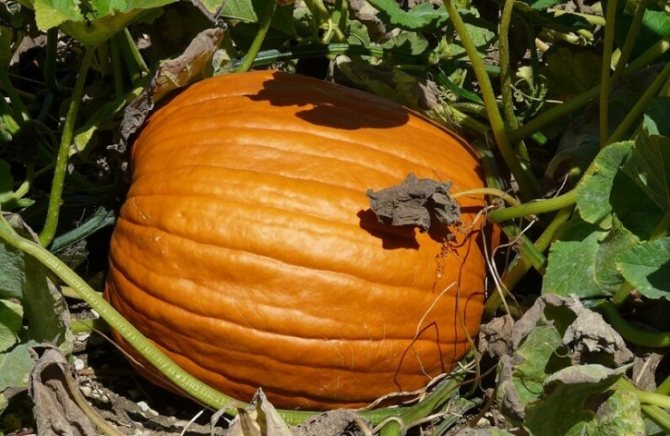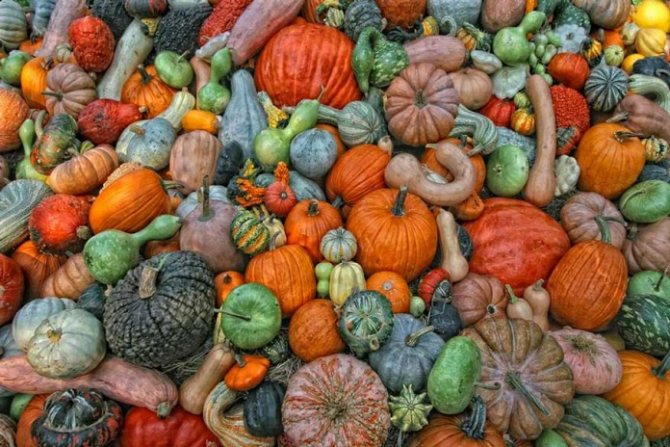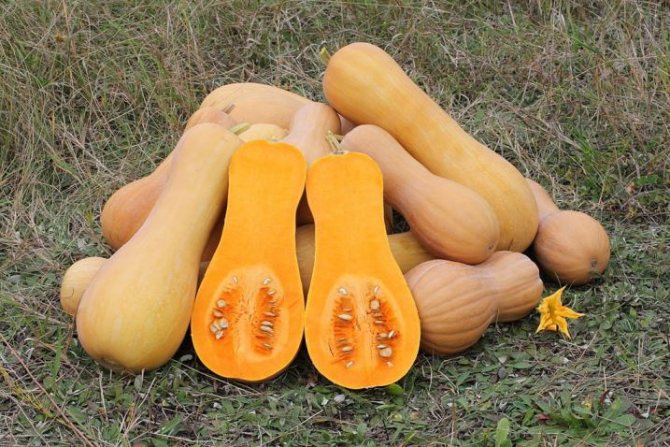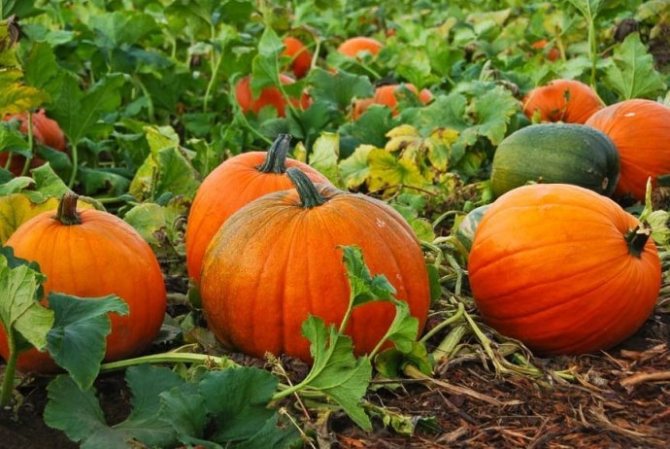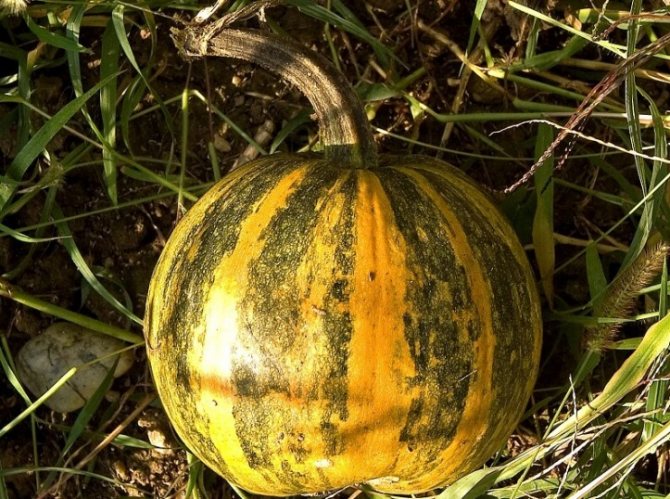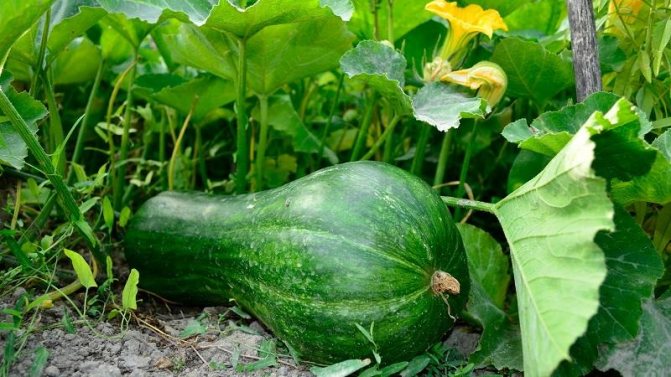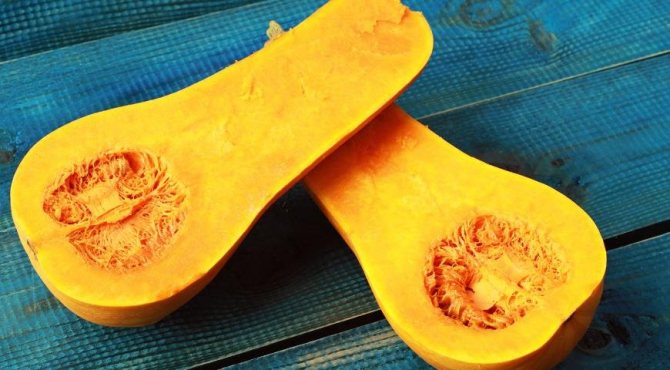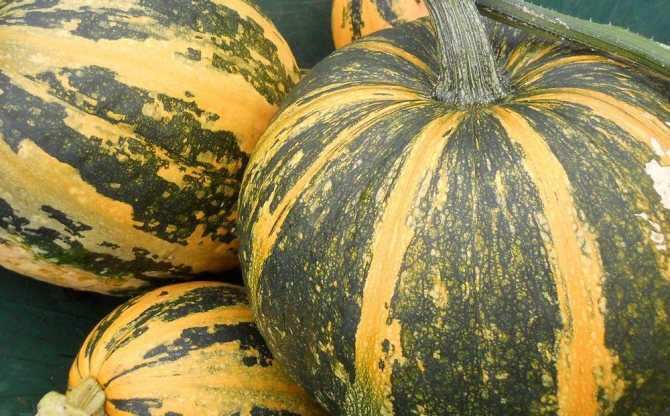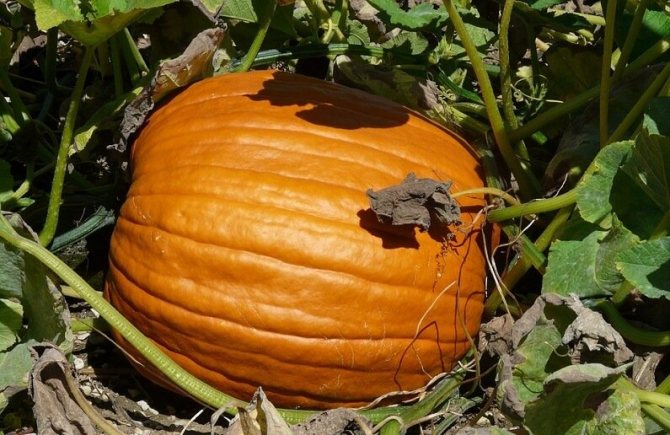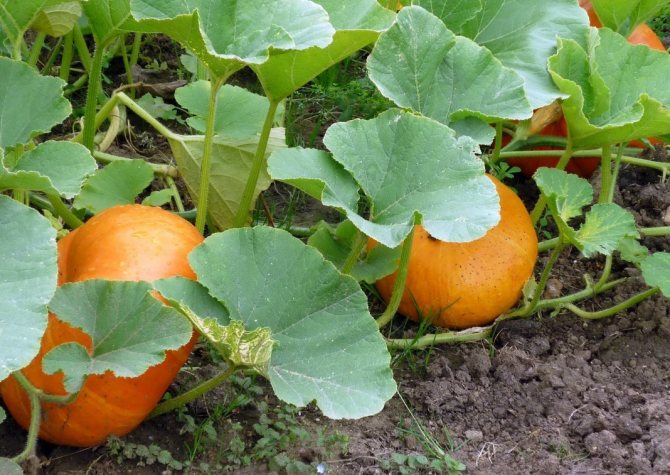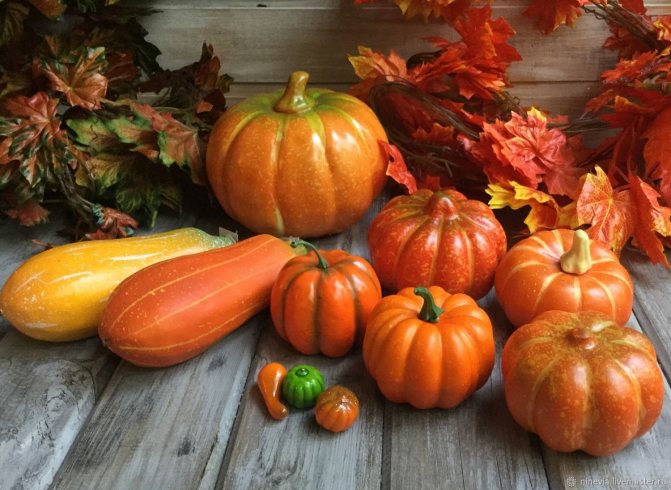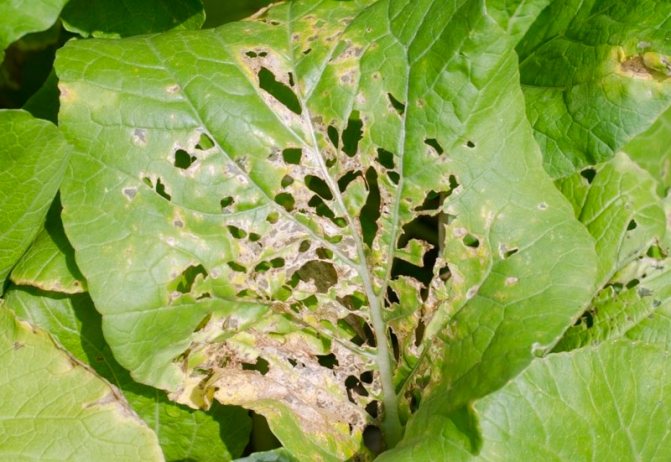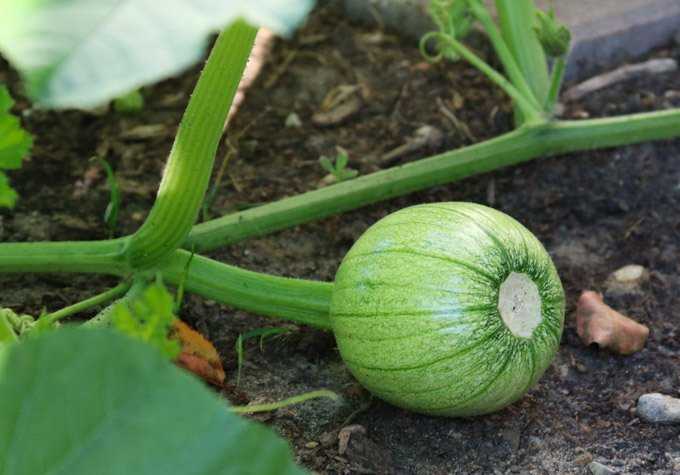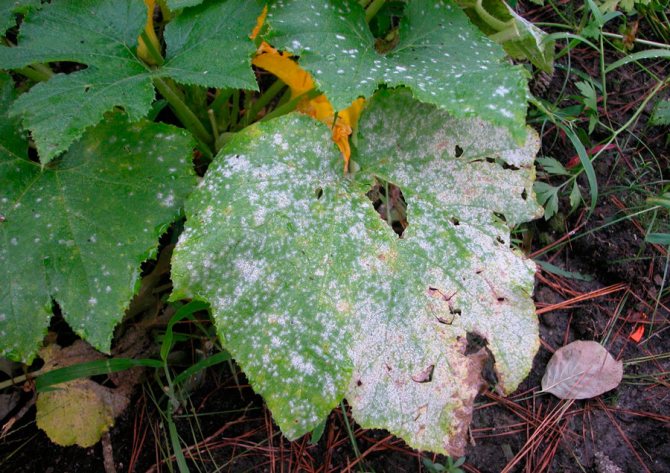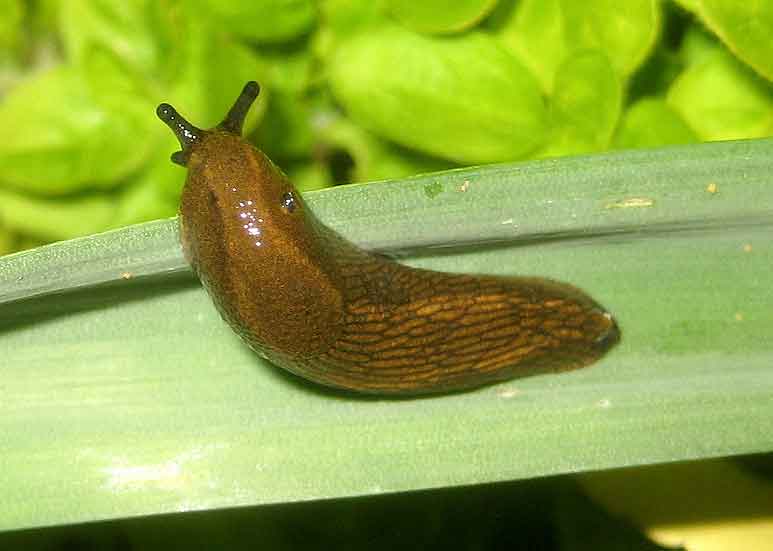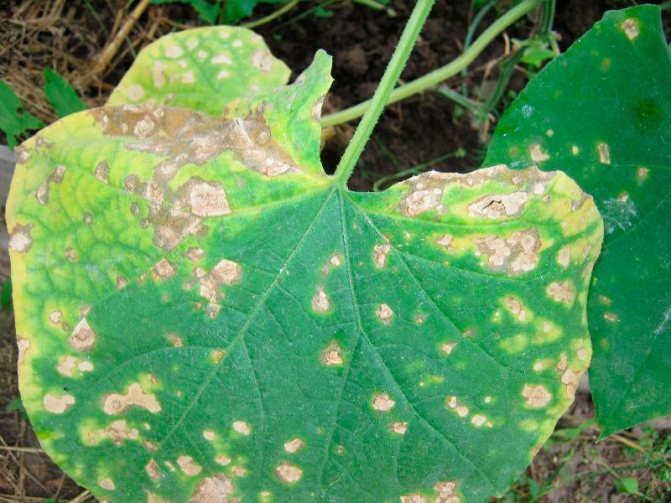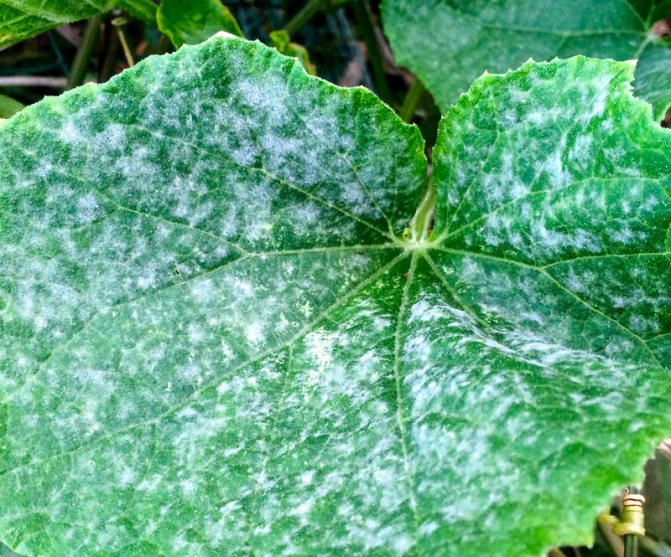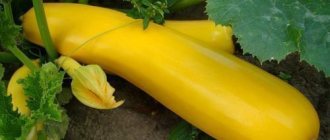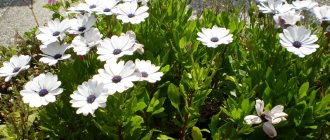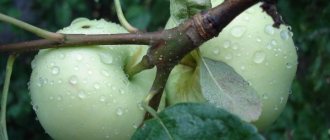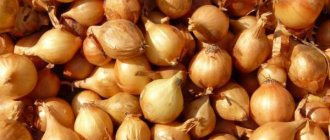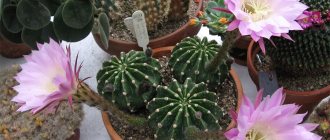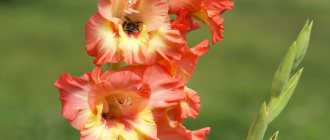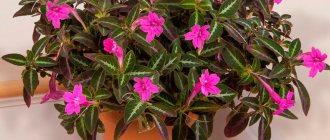The first to grow pumpkin were Mexican Indians many centuries ago. They prepared various dishes from bright fruits, made dishes and even rugs from pumpkin peels. The plant was brought to Europe by Spanish sailors about 500 years ago. Europeans liked the new product. Today, a healthy vegetable is cultivated on all continents except Antarctica.
In our country, pumpkin is loved by gardeners and gardeners. It is grown in all regions of the country, except for the Far North. The bright orange fruits are tasty and healthy and keep well in winter. Ornamental varieties of culture adorn an unsightly fence in a country house or garden plot. In the article we will talk about growing and caring for pumpkin in the open field.
Reviews of the most popular varieties
What is the name of a curly pumpkin in the form of a pear? How to fertilize pumpkin beds? Small reviews on the most popular pear-shaped varieties will help answer these questions.
Prikubanskaya
Belongs to nutmeg varieties, has a delicate and juicy taste. Prikubanskaya resembles a ripe sweet melon. This variety is mid-season, summer residents harvest in 120-130 days from the moment of planting. The bushes are semi-spreading, the length of the lashes is about 0.3 m. The pumpkins are elongated, in shape they resemble a thin and long pear. The color is brown-yellow, brown spots are visible on the surface. The pulp is red-orange, the rind is firm. Prikubanskaya is well stored and transported. The yield is stable, from 1 sq. m gardeners collect about 2 kg of ripe and tasty fruits.
The nutmeg variety is used to prepare healthy and dietary meals. From the fruits, you can make cream soup, vegetable stew, vitamin salads and even sweet pastries: muffins, pies, cheesecakes, pancakes. Such tasty and low-calorie dishes are good for the body, saturate it with vitamins A and B, iron, beta-carotene, calcium and magnesium. At the same time, they do not harm the figure, because 100 g of Prikubanskaya contains only 28 kcal.
Pearl
Mid late grade, the pumpkin ripens in 130-140 days. It is recommended to plant in the middle lane or in the south of the country. Fertile and sunny beds are great for growing. Before planting, the land is carefully dug up and fertilized with peat. To obtain a rich harvest, summer residents recommend planting the variety in seedlings. To do this, a month before planting, seedlings are prepared: soil, seeds are poured into clean containers and placed on the windowsill. Every 10 days, the seedlings are watered with warm water, once every two weeks they are fed with organic fertilizers, for example, liquid bird droppings.
The average fruit length is about 40-50 cm, weight varies from 5 to 7 kg. The peel is thin, there are few seeds. The pulp is crispy and dense, due to the high content of carotene, it has a bright yellow color. The variety is sweet, so it is consumed both fresh and after heat treatment. The pearl is distinguished by its high immunity to diseases and insect pests. Stores well up to 4-5 months.
New
Another pear-shaped representative of the nutmeg varieties ripens within 110-115 days. Novelty is planted after spring frosts. The distance between the bushes should be at least 60-70 cm. Pumpkins are watered every 5-7 days, about 1.5 liters of warm water are used for one bush. If the summer is rainy, then the amount of watering is reduced. Fertilize the variety three times per season. Summer residents are advised to alternate organic matter and mineral fertilizers.Wood ash, Bordeaux liquid, nitrogen-containing preparations, mineral complexes are used as top dressing.
The average weight of the fruit is 4 kg, the length is about 50 cm. The pumpkin has an orange-yellow color, dense flesh and excellent taste. The novelty has good transportability and can be stored for up to 6-8 months. As a rule, wooden boxes and dry ventilated areas, such as a cellar or basement, are used for storage. The yield is high, about 5 kg per 1 sq. m.
Sugar mace
The hybrid has a high immunity to diseases and pests. However, experienced gardeners still pay special attention to preventive measures. To prevent the plant from getting sick with powdery mildew, it is sprayed with milk whey 2-3 times per season. To protect the crop from aphids, slugs and spider mites, vegetables are fertilized with Bordeaux liquid or a solution of copper sulfate. These methods not only protect the beds from negative factors, but also improve the palatability of the pumpkin.
Nutmeg hybrid Sugar mace belongs to the early maturing, ripens in 90-100 days from the moment of planting. Fruits are long and curved; at the stage of technical ripeness they are green and then turn light beige. The pulp is rich yellow, the aroma is sweet, nutmeg. Pumpkin weight varies from 1 to 2 kg. Gardeners appreciate the hybrid for its high yield, from 1 sq. m collect about 15-20 kg of unusual vegetables.
Pineapple
The hybrid ripens in 100-110 days, suitable for cultivation in the south of the country... Pineapple has a tasty pulp, contains a large amount of vitamins and minerals. Fruit weight is about 2 kg. The pumpkin has a light orange color, firm and crunchy flesh. It keeps well, it is often grown on an industrial scale. The product is consumed fresh, boiled, steamed and even fried.
Interesting! Regular consumption of pumpkin slows down the aging process of the body, improves the quality of skin, hair and nails. In addition to pumpkin pulp, seeds are often used: they have a high content of copper, zinc and phosphorus.
Butternut
This variety is often called "nut pumpkin", the taste of the fruit is filled with nutmeg notes. The pear-shaped pumpkin weighs 1-1.5 kg. It has a dense skin and a yellow-orange color. The variety is early ripening, ripens in 2.5-3 months. The vegetable is planted in greenhouses or in the open air. Before planting, be sure to disinfect seeds, beds and garden tools. When grown in seedlings, seedlings are hardened.
FEED PUMPKIN - THE BEST CHOICE
When choosing a pumpkin for growing for fodder purposes, you should focus on the ripening period, yield, unpretentiousness, ease of use, shelf life, the ability to accumulate a large amount of sugars. Animals love sweets too!
Therefore, it is worth planting varieties that form 3-4 fruits weighing 5-10 kg on a bush. Larger fruits require more space and are difficult to transport. In addition, they are less sweet, contain less carotene, and generally have a lower shelf life. And one more nuance: the fruits of large-fruited pumpkin are thin-cored and will not damage the stomach and intestines of animals.
ORDER QUALITY AND CHEAP SEEDS AND OTHER GOODS FOR HOME AND COTTAGE. PRICES ARE BOTTLE. CHECKED! JUST LOOK FOR YOURSELF AND BE AMAZED HOW WE HAVE REVIEWS. GO >>>
Below are other entries on the topic "Cottage and garden - do it yourself"
- How to properly preserve pumpkin - preserve vitamins: Storing pumpkin - like everyone else ...
- Varieties of small-fruited pumpkins - photo, name and description: The best varieties of small, miniature pumpkins S ...
- Grafting a cucumber on a pumpkin: How to graft a cucumber on a pumpkin Prepare ...
- Growing pumpkins on grass heaps - my reviews: How to grow a pumpkin on compost, ...
- Pumpkin variety "Musc de Provence" - planting and care: Growing pumpkin Musc de Provence variety ...
- Cyclanter planting and care: Cultivation of edible cyclantera Edible and fruit, ...
- Wax pumpkin benincasa - cultivation, planting and care: Pumpkin benincasa - wax, varieties ...
Subscribe to updates in our groups and share.
Reviews of summer residents
Most summer residents prefer to grow beautiful and juicy pear-shaped pumpkins. Many are attracted by the classic orange color and melon aroma. However, sometimes expectations are not met: instead of large and attractive fruits, small and watery pumpkins grow.
Arina, Ufa: “I have been growing pear-shaped pumpkins for a long time. My favorites are Novinka and Zhemchuzhina varieties. They are similar to each other, have a juicy and sweet pulp. However, the Novinka variety is more productive. I dry the pumpkin seeds and add them to baked goods, and from the pulp I make porridge and sweet jam for the winter. "
Olga, Moscow: "I prefer only nutmeg varieties. They have amazing taste and aroma. In leaving, they are capricious, but if all agrotechnical rules are followed, problems do not arise. I especially like to make vitamin juice with ginger and lemon out of them, as well as cook porridge for breakfast. "
Milan, Yekaterinburg: “I always plant pumpkins in the greenhouse. I especially love Pineapple. She is unpretentious in care, rarely gets sick. Before planting, be sure to disinfect the seeds and prepare the seedlings. I harvest in early September. We eat something right away, and leave the other part for the winter. "
Why is a pear-shaped pumpkin good
The variety of pumpkin crops is great. However, not all varieties are suitable for cultivation in the climate of the Moscow region. The weather here is typical for the middle zone. A sharp cold snap is possible, there is no stability in temperatures, a small number of sunny days. Therefore, it is necessary to select varieties that do not require long-term high temperatures.
Chit
This is a unique white pumpkin. It is characterized by the presence of small fruits that can be eaten at one time. Mid-season variety with well-recognizable fruits. The average weight of one pumpkin is 2.5 kg.
Advantages:
- long shelf life;
- tolerates transportation well;
- suitable for industrial cultivation;
- pronounced honey taste of the pulp;
- unpretentious.
Sweet pie
This species with an unusual name is ideal for preparing delicious dishes. Belongs to the group of early maturing varieties. Differs in tasty, bright pulp. Average fetal weight is 2 kg.
Melon
A mid-season variety with an amazing melon-like aroma. Melon pumpkin gives a large number of bright fruits. The outer skin is yellow. They can be stored for a long time if kept dry.
The pulp has a very rich orange color, dense, aromatic, sweet. A distinctive feature is the weight of the pumpkins. One fruit can reach 30 kg.
Pastila Champagne
An amazing variety with an unusual appearance. The pumpkin is elongated, oval. The skin is pinkish.
Features:
- has a vanilla aroma;
- can be eaten without preliminary heat treatment;
- the pulp is orange or yellow;
- a large percentage of pulp from the total;
- weight 3 kg;
- suitable for table use, sap making.
Dawn
A plant with an extensive vegetative part. Pumpkin weight varies within 4 kg. Segments stand out on the surface of the fetus. Skin color is light green, with yellow and orange splashes.
Average taste. The pulp is rather coarse and fibrous. Little juice. Suitable for cereals, side dishes.
Almond
Hard-bored variety, excellent transport tolerance. Pumpkin Almond has flattened fruits, inside of which is hidden orange dense pulp. The taste is pleasant, sweetish. On the surface of the skin, green stripes are drawn on a light orange background.
Russian woman
The variety is easily recognizable due to its unusual fruit shape. The variety Rossiyanka has domed pumpkins with a bright red skin.Unpretentious, mid-season species, suitable for the Leningrad region, Moscow region.
The taste is sweet. There is a light aroma reminiscent of a melon. Average weight 4 kg.
Gardeners love the pear-shaped pumpkin for its interesting appearance (see photo). The attractive and vibrant fruit looks delicious and looks great on any table. Summer residents appreciate these fruits for the following advantages:
- tasty and juicy pulp;
- vitamin composition;
- unpretentious care;
- versatility in application;
- decorativeness;
- high and stable yield.
Inside view
Butternut squash is an excellent material not only for fabulous transport. On Halloween, it gives great possibilities for the design of festive lantern faces. However, the main advantages are considered to be her "inner world". The pulp is juicy, sweet, has dietary properties. The body easily and with pleasure assimilates the pumpkin.
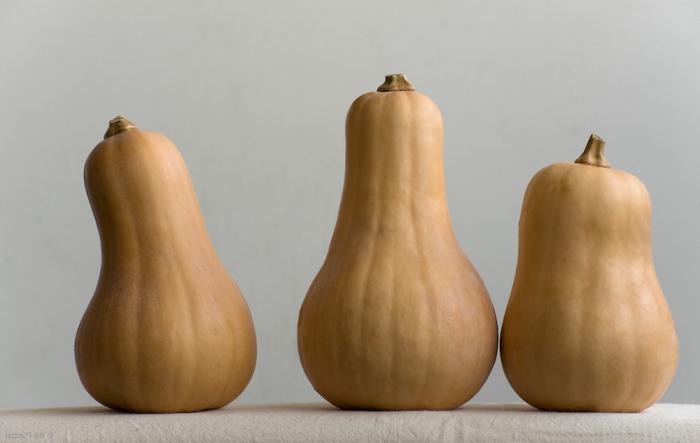
Many dishes are prepared from the fruit, which become favorite among demanding gourmets not only for its taste, but also for its low calorie content. In 100 grams, more than 31 units will not be typed.
Pumpkin varieties with large fruits
Many gardeners strive to grow a truly gigantic vegetable. There are many champions among the representatives of this culture. To achieve the cherished goal is not enough to properly care for the plant. A prerequisite for success is a correctly selected variety that gives large fruits.
Large-fruited types of pumpkin:
- Lamp;
- Titanium;
- Centner;
- Atlantic giant;
- Fatty;
- Parisian gold;
- Russian porridge.
Pumpkin lantern
The average weight of one fruit of this breeding variety is about 6 kg. With proper care and feeding, larger specimens can be obtained. The variety has a long shelf life. Juicy, crunchy flesh is hidden under a rather thin skin.
Russian porridge
Table variety, distinguished by large fruits. The average weight of a pumpkin is 7 kg. Fruits are rounded, bright orange with a slight pink tint.
Characteristic:
- mid-season;
- up to 4 fruits ripen on one plant;
- the pulp has a pleasant aroma, balanced taste;
- used in cooking for the preparation of side dishes, soups, cereals.
Benefit and harm
Nutmeg pumpkin is rich in vitamins. The varieties are different, but regardless of the type, the fruits contain pectins, mineral salts (phosphorus, zinc, magnesium, calcium, selenium, manganese, copper) necessary for a person. In the presence of carotene, pumpkin is several times superior to the more familiar carrots. For those who attack the accumulated fat folds, overweight, dishes from the orange beauty will be a real salvation.
It is recommended to include pumpkin in the diet of pregnant women. It will be useful for people inclined to "matters of the heart" to use this valuable product. It is said that butternut squash helps to reduce the risk of strokes, arrhythmias. Oncology is also included in the list of diseases for which the use of the fetus is recommended.
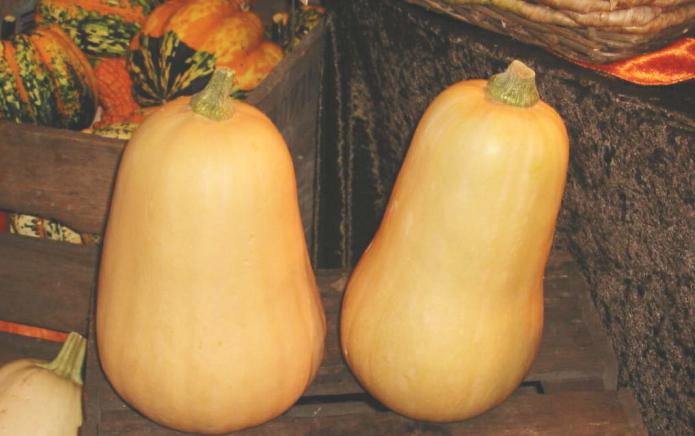

Additional valuable bonuses are a general strengthening effect on the immune system, a beneficial effect on the condition in case of renal ailments and liver disease. In addition, pumpkin has laxative and choleretic properties.
Timing for planting pumpkin
When determining the timing of growing crops, they are guided by the climatic conditions of a particular region. It should be borne in mind that southern beauty does not tolerate cold weather... Landing in open ground is carried out only after warm weather is established.
In Belarus, Ukraine, southern Russia, the dates fall in the second half of May.
In the Leningrad Region and Moscow Region - at the beginning of June.
In the Urals and Siberia - in mid-June.
Varieties
Butternut squash is usually pear-shaped. Some people compare her graceful figure to an hourglass. But this is far from the only option for the appearance of a sweet beauty.
Today, nutmeg pumpkin is also grown on Russian lands. We will now list the varieties that can most often be found on domestic farmers. It:
- muscat pumpkin "Pearl" of cylindrical shape. The weight can be up to 7.5 kg. Has a delicate insides;
- nutmeg pumpkin "Vitamin", shape - elongated, weight up to 7 kg with crispy pulp;
- Prikubanskaya nutmeg pumpkin, small, reaches only 4 kg, the pulp is sweet, tender.
Other varieties are also suitable for the non-black earth zone. For example, "Marble" pumpkin, the average weight of which is 5 kg. It is distinguished by a spotted, grayish crust covered with tubercles. Inside, it is traditionally orange, very sweet. You can store the fruits for up to 9 months.
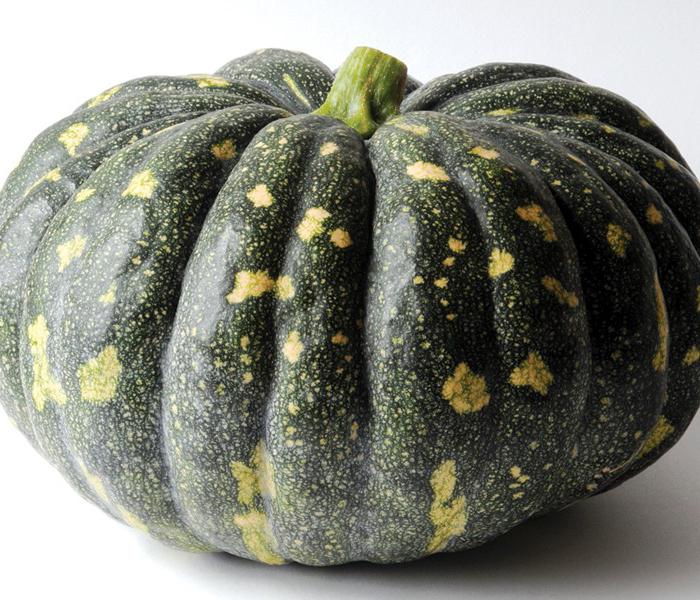

Pumpkin "Arbatskaya" can reach a weight of 20 kg. Its cylindrical shape thickens towards the apex. The rind is very bright, golden orange. It is considered one of the late varieties by maturity. The “Delicacy” pumpkin overtakes in ripeness. Outwardly, it resembles a sports dumbbell. Unlike other species, this fruit has very few seeds inside. The Golden Pear variety is compared with a small drop. Having a modest weight, up to 2 kg, it tastes slightly nutty.
Numerous varieties of butternut pumpkin are grown today by Russian farmers. High popularity is explained not only by valuable qualities, nutritional properties, excellent taste. Butternut squash can be stored for a long time without requiring particularly sophisticated conditions. Therefore, dishes made from this fruit can be seen on the table in any, even the coldest season.
Features of cultivation in different regions of Russia
The unpretentious pumpkin is cultivated throughout Russia, except for the Far North. In each region, the cultivation of a crop has its own characteristics.
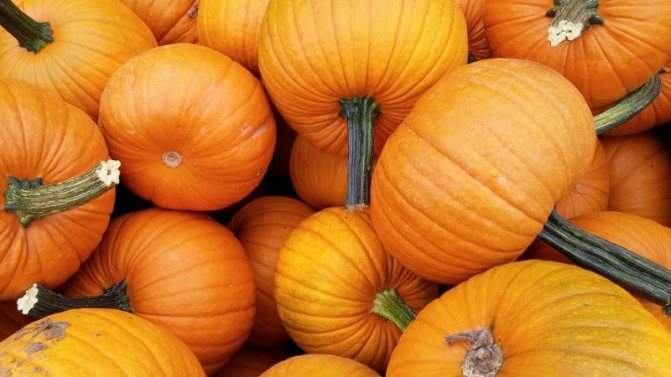

In Siberia and the Urals
In regions with cool and short summers, predominantly early and mid-season varieties are grown. When choosing, pay attention to the resistance of the variety to temperature extremes.
In Siberia and the Urals, pumpkin is cultivated by seedlings, since the threat of return frosts persists even in June.
In outskirts of Moscow
Here, early-maturing varieties are planted immediately in open ground. Mid-season and late - through seedlings.
Dishes and recipes
What to cook with butternut squash? Experienced chefs will name a dozen of dishes right off the bat. Porridge, soup, cutlets, side dishes. Many options for stuffing the fruit. Pumpkin is added to baked goods, sauces, creams.
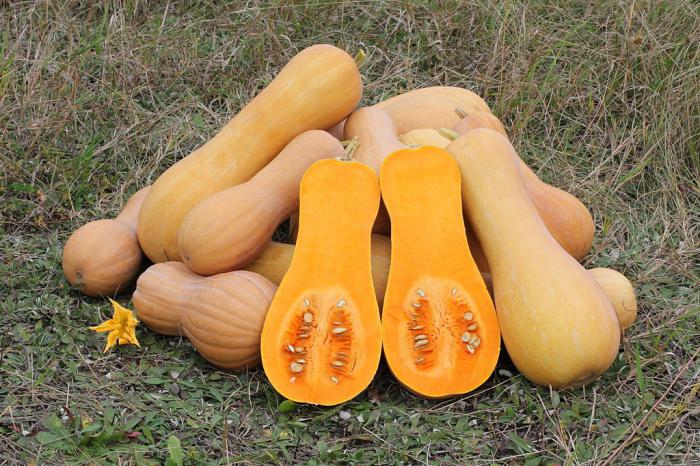

For any celebration, you can prepare a festive hearty dish. Butternut pumpkin will also help surprise guests. There are many dishes from this product. For example, baked fruit with a filling.
Tips and tricks from experienced gardeners
When cultivating pumpkin, the following recommendations from experienced farmers will help:
- when growing in areas with cool and short summers, use warm beds;
- sprinkle the side shoots with earth to form additional roots;
- follow the rules of crop rotation;
- place the pumpkin in sunny, spacious areas;
- do not allow the fruit to come into contact with the ground: this may cause spoilage. Place boards or other suitable material under the pumpkins.
Cooking process
If the oven is old-fashioned, it is better to preheat it beforehand. The required temperature is 170 degrees.
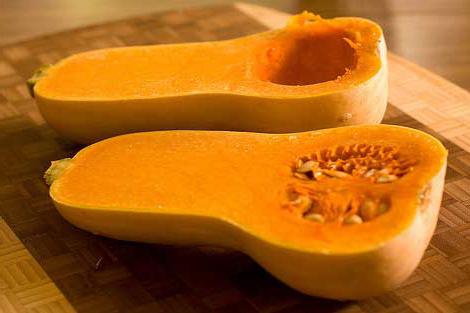

The first step is to prepare the pumpkin. To do this, you need to cut it lengthwise. The pear-shaped nutmeg has a depression at the top where the seeds are placed. They should be removed along with the connecting fibers. The result should look like two boats.
The next step is to process the pumpkin pulp. Notches are applied to the surface with a mesh. The cuts should not damage the skin, but they should be made deep enough.
A must for this dish is the marinade. It contains dried thyme, garlic, ground red and black pepper, olive oil. Combine all the ingredients in a bowl.Pre-grind the garlic, you can pass it through a crusher and grater. Beat the resulting mass well with a fork, whisk or mixer.
With a culinary brush or feather, the marinade is applied to the dissected surface of the pumpkin. The poured halves should be allowed to stand for a while so that the dressing seeps into the notches, soaking the pulp.
Pumpkin blanks treated with marinade should be placed on a baking sheet lined with parchment, or in a special container with a heat-resistant surface. The halves are loaded into a hot oven. Roasting time from 1.5 to 2 hours, depending on the size of the workpieces.
While the pumpkin is in the oven, prepare the main dressing for the dish. Sweet pepper is cut into small cubes. Zucchini is processed in the same way. If it is young and with a thin skin, then peeling it is not necessary. The more mature fruit should be peeled and the seeds cleaned. Curd cheese is cut into cubes. A little set aside for decoration. The main part is in the filling. The leeks are cut into rings of medium thickness.
Spices, salt are added to the minced meat, everything is thoroughly mixed. For satiety, you can use boiled rice.
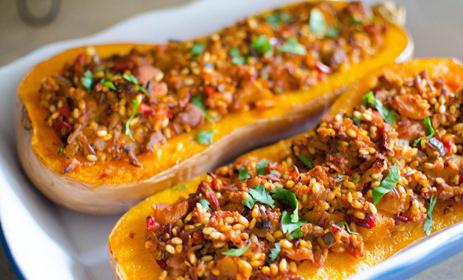

The frying pan is heated over the fire. In vegetable oil, the vegetable part of the filling is fried until the onion acquires a golden hue, then salted. After that, minced meat is added to it. Leave on low heat until tender. Cheese is added to the filling. Stir the mass over the fire until it melts.
Butternut squash dishes are particularly juicy. The baked halves, taken out of the oven, also give juice, which is better not to pour out of the boats. Then the pulp will become even more tender, richer.
The filling is laid out in grooves with a slide. And the halves are sent back to the oven. The residence time is 10-15 minutes. Then the blanks are pulled out again, the rest of the cheese is laid out on top. The last stage is 7-10 minutes of baking (until the cheese melts).
Sprinkle the prepared halves with herbs and serve on a large platter. Baked pumpkin will become a royal treat and table decoration! It looks delicious and tastes very juicy. The main thing is satisfying.
Gourmets know how many first courses a butternut squash can decorate with its presence. The recipes are improved almost daily, each chef brings something of his own. We will consider one of the main ones below.
Varieties of hard-barked pumpkin
A distinctive feature of this group is the presence of a thick crust. It protects the fruit from damage and decay. Hardy varieties are stored for a long time, they tolerate transportation well over long distances.
A very aromatic and sugary pulp with excellent taste is hidden under the dense skin. For this, they love hard varieties. Typical representatives of this pumpkin variety:
- Bulgarian;
- Bun;
- Gymnosperm.
Bun
The early ripe variety is great for desserts, juices, and the first complementary foods for babies. Due to its pleasant taste, the fruit can be eaten even raw.
Distinctive features:
- many small pumpkins are formed on the plant;
- weight does not exceed 2 kg;
- the pulp is bright, orange;
- pronounced sweet taste due to the large amount of natural sugars in the composition;
- demanding storage conditions, does not tolerate moisture.
Gymnosperm
A rather capricious variety of this vegetable, obtained by American breeders. Gymnospermous gourd loves warm and humid growing areas. The appearance makes the variety easily recognizable:
- spherical fruits;
- skin color - yellow with green stripes.
Gymnosperm gourd is grown for seeds.
Cooking
We clean the pumpkin from the peel and seeds. Then cut into medium-sized cubes. We process potatoes in the same way. Finely chop celery, carrots and onions.
You will need a large saucepan to make the soup. The butter is melted right in it. Fill in chopped onions, celery, fry the carrots, add cubes of potatoes and pumpkin.Simmer for five minutes until lightly golden brown.
Pour in the broth so that the liquid completely covers the vegetable mass. After the broth has boiled, reduce the heat and cover the pan with a lid. Cook for 35-40 minutes.
Cool the soup slightly. Pour into a blender and blend until smooth. Pour into a saucepan again, pour out the rest of the broth, put on fire for a few minutes. Add salt and spices to taste. Serve with herbs.
If we discard thoughts about the benefits, and first of all emphasize the taste, then you should pay attention to desserts where butternut pumpkin is used. Recipes for making mashed potatoes, jelly, even cakes from an orange beauty should be kept in every housewife's culinary notebook.
Care plan by month
After sprouting or planting seedlings in open ground in June, caring for pumpkin plantings consists of regular watering, fertilizing, loosening the soil and removing weeds.
In June, while the plants are still small, deep soil moisture is not required. After watering, the soil is loosened, providing oxygen to the roots. A few days after planting, fertilizers are applied (nitrophoska, ash, mullein or rotted manure).
By July, the pumpkin bushes grow, forming a powerful root system. During this period, the earth is loosened carefully and shallowly so as not to damage the roots. Water abundantly, as large leaves evaporate a lot of moisture. They continue to make top dressing.
In August, watering is reduced, and at the end of the month it is stopped altogether. Fertilizers are no longer applied. During this period, the fruits accumulate sugars and gain sweetness.
Pumpkin care
Pumpkin care is not difficult. The main measure is timely watering. The pumpkin root system is large enough, it feeds on all nutrients and moisture from the soil at all stages of growth. Water the pumpkin at the base of the plant, at the root. When the weather is hot or dry, pumpkin especially needs moisture.
During the ripening period of pumpkins, watering should be moderate, since at this time the fruits ripen under the sun and gain sugar content.
Weed removal is an important step in plant care.
The pumpkin is fed in several stages. The first feeding falls on the period when the seedling has 3 pairs of leaves, and the second - during the period of lash formation.
To do this, use a nitrophosphate, for the first feeding in the amount of 10 g, for the second - 15 g. One pumpkin bush.
Soil loosening
Loosening is an important technique in the cultivation of crops, including pumpkin. It is recommended to avoid the formation of a crust of soil under the plant. Maintain looseness of the soil and thereby provide aeration of the rhizome.
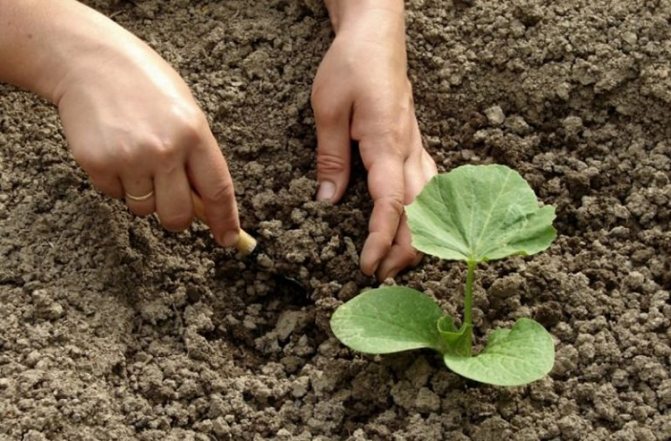

Formation of a pumpkin into one and several stems
The pumpkin grows pretty quickly at the beginning. Since this is a spreading plant, the territorial boundaries of the culture must be observed. For this, pumpkin bushes are formed during the opening of the lashes. Before the first inflorescences appear, it is necessary to pinch the bud at the top of the shoot. This is done in order to allow lateral shoots to grow.
You should also remove young shoots growing "in the bosom", reaching 5-7 cm.
Such measures prevent the expenditure of the vital forces of the plant on extra leaves and whips, directing them to the formation and cultivation of pumpkin fruits directly.
One ovary should be left on each branch.
Chemical composition and calorie content
Next, let's look at the chemical composition of the product.
100 g of pumpkin contains:
- proteins - 0.9 g;
- carbohydrates - 5.9 g (including mono- and disaccharides - 4.1 g);
- pectins - 0.3 g;
- organic acids - 0.1 g
The amount of water in the vegetable is 90.2 g, and the ash - 0.5 g. The saturation of the fruit with fiber is 1.2 g. Pumpkin is famous for its considerable concentration of vitamins.
Read more
Features of the structure of pumpkin, chemical composition, benefits and harms of use
The organics in the product are represented as follows:
- retinol - 1.4 mg;
- thiamine - 0.05 mg;
- riboflavin - 0.06 mg;
- niacin - 0.5 mg;
- folic acid - 6 mcg;
- ascorbic acid - 14 mg.
Macronutrients irreplaceable for the body are found in orange fruits in such quantities:
- potassium - 200 mg;
- calcium - 26 mg;
- magnesium - 14 mg;
- sodium - 4 mg;
- phosphorus - 24 mg.
Saturation with trace elements:
- iron - 0.4 mg;
- iodine - 1 μg;
- cobalt - 1 μg;
- manganese - 38 mcg;
- copper - 180 mcg;
- fluorine - 84 mcg;
- zinc - 240 mcg.
Pumpkin is characterized by a fairly high energy value: 100 g of raw product contains on average about 25 kcal.
Important! The calorie content of pumpkin seeds is 25 times higher than the calorie content of pulp: 100 g of seeds contains 556 kcal.
Types and features of the plant
Some varieties of the southern culture are grown because of the delicious fruits, others because of the originality of the forms. What are snake, cobra, polenta, and common lagenarii? Where did their names come from, what are the similarities and differences with each other, what are the benefits of creeping vines of a bottle or dish pumpkin - let's take a closer look.
Calabaza
The fruit of this species is able to surprise with its size. Up to 50 cm in length, elongated top, it resembles a large pear. It makes comfortable decorative jugs.
But 50 cm is not the limit, two-meter pears grow, but extremely rarely. Pumpkin ripens within 200 days after sowing. The length of the lashes reaches 15 m with regular exposure to sunlight.
Description of culture
The vegetable plant belonging to the genus Cucurbita has 18 varieties. Of these, only 3 species are characterized by nutritional value, the rest can be considered as forage and ornamental varieties.
The history of the emergence of this plant has very ancient roots. Central America is considered the birthplace of the first cultivation of pumpkin plants. Moreover, several subspecies were found in Africa and Asia Minor.
Pumpkin was brought to Russia in the 19th century. Since that time, culture has come to be regarded as a valuable food product. Breeders divide the pumpkin used for food into three types:
- Hard-faced. This type is presented on the market of vegetables in dozens of varieties. Among them there are bushy, climbing and ornamental crops. This category also includes zucchini and squash, the crust of which is gaining firmness throughout the entire ripening period.
- Large-fruited. Has gained popularity all over the world. In Russia, varieties of this type can gain weight up to 60 kilograms, while their sugar content is 15%.
- Muscat. It belongs to the most delicious varieties. In terms of external characteristics, it has a similarity with hard-bore and large-fruited plants. However, the flesh of the Muscat species is not comparable to them: their sugar content reaches 11%, the structure is dense, oily, and the aroma is delicate. This species is represented by many varieties, but for cooking, gardeners give the greatest preference to a pear-shaped variety. Cold-resistant varieties are grown in Russia, in which the fruits ripen in 3-4 months.
The nutritional value of pumpkin is due to its rich composition. This culture contains a large amount of pectin. Orange varieties contain more carotene than carrots. Also, the benefits of a vegetable are due to the presence of minerals such as phosphorus, potassium, calcium and iron in it.
The maximum sugar content of the sweetest fruits is 15%. In this case, you should be aware that the growing conditions of the plant affect the sugar content. The more the fruits receive sun and heat during the ripening period, the sweeter their pulp becomes.
What to do to make the pumpkin grow huge?
For record lovers, it remains to add that the following factors are necessary for increased weight gain:
- Additional feeding.Usually it is not only nitrogen fertilizers, but also fertilizers containing potassium and phosphorus.
- Sufficient sunlight and moisture.
- Good genetics. Real giants grow from the seeds of the same giants.
However, giant pumpkins are not used for food. They are 90-95% water, and the content of nutrients in them is minimal. They have a very thin layer of pulp, the pumpkin is almost empty.
Contraindications and side effects
Unfortunately, the presented vegetable has more than just beneficial properties.
- You should not include it on the menu if you suffer from the following ailments:
- chronic diseases of the gastrointestinal tract (especially in the stages of exacerbation);
- failure of acid-base balance in the body;
- diabetes.
An individual allergic reaction may become a reason for refusing pumpkin. Some people experience flatulence when consuming this vegetable. Children may have colic. If you also notice a negative reaction of your body, then it is better to refrain from consuming pumpkin.
Important! Pumpkin seeds are especially harmful for expectant mothers.
—
they can cause premature birth. If you want to include a pumpkin in your menu during the period of bearing a child, you should first consult a doctor.
Frequent consumption of seeds can provoke nausea and vomiting. Pumpkin juice can cause side effects like bloating, diarrhea, and nausea.
Lagenaria: plant propagation
Start growing seedlings for plant propagation at the end of April. Pre-soak the seeds in water for a day, then spread on moistened sawdust at 25 ° C. This will help them germinate. Deepen the seeds 3 cm into the organic soil. When seedlings appear, plant them in separate pots. Growing and caring for seedlings is similar to a regular pumpkin.
Advice. For planting on a garden bed, the seedlings will be ready in about 35-40 days.
Protecting pumpkin from diseases and pests
The most common pumpkin diseases are fruit rot, powdery mildew and mosaic. Most often they appear due to increased dampness - a favorable environment for the development of bacteria and fungi. Of the pests, the spider mite most often affects the pumpkin, as well as the melon aphid.
Powdery mildew
When the first symptoms of a fungal disease are detected on the leaves of the pumpkin, they are fought with a solution of 3 g of potassium permanganate or 2 g of copper sulfate, dissolved in 10 liters of water. They are treated with 1% Bordeaux liquid during the formation of ovaries and leaves. For prevention, regular watering is carried out, crop rotation is observed and the remains of diseased plants are destroyed.
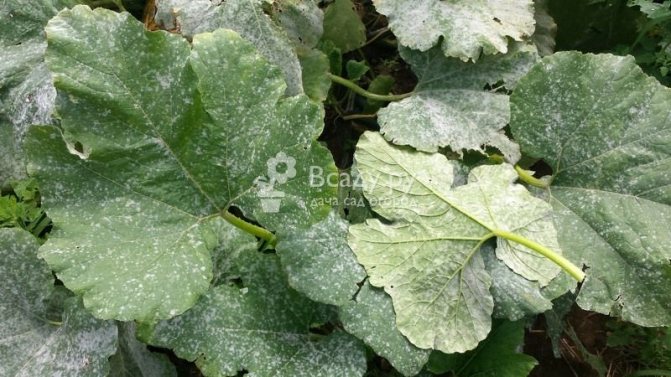

Powdery mildew on pumpkin leaves
Pumpkin mosaic
A dangerous viral disease, infected plants are removed and burned away from the site. Preventive measures: destruction of weeds, disinfection of garden tools, destruction of parasites, timely removal of affected areas.
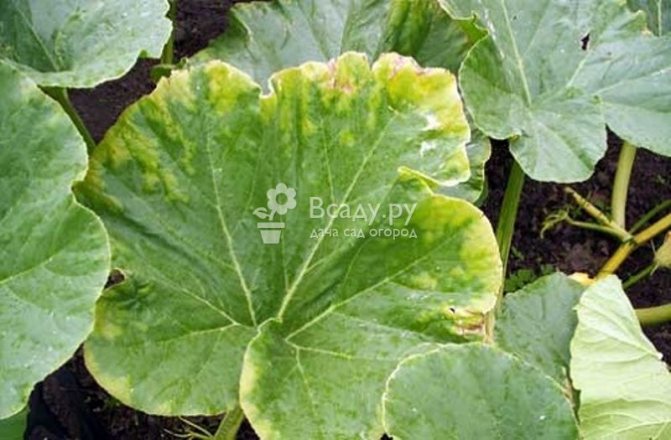

Pumpkin mosaic in the initial stage
Fruit rot
The decayed areas are carefully removed with a knife and the wound is wiped with fresh aloe juice. The rubbed area dries up, and the pumpkin continues to develop.
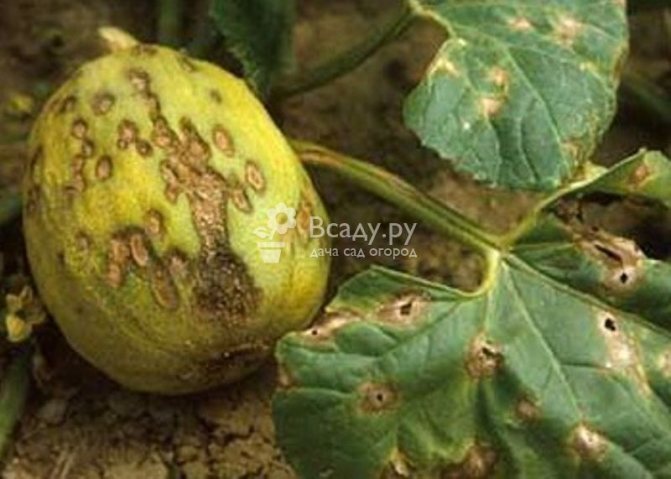

Pumpkin Fruit Rot
Insect protection methods
Aphids are fought by removing weeds, spraying with soapy water (200 g of grated soap per 10 liters of water) or 10% karbofos in a proportion of 60 g per 10 liters of water.
Spraying a spider mite is helped by spraying with onion infusion of 200 g of husk per 10 liters of water or 20% chloroethanol solution (20 g per 10 liters of water).
Useful properties of pumpkin
Grown vegetables are fully used for cooking and harvesting. Pumpkin is a storehouse of vitamins
which are contained in the pulp and seeds.
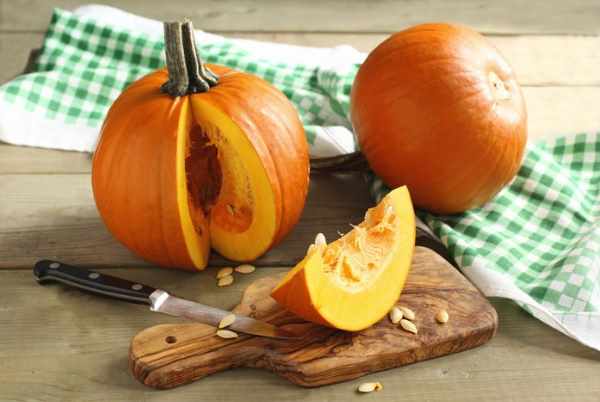

A healthy and tasty oil is made from the seeds, which is low-allergenic, has a regenerating and anti-inflammatory effect.
The pulp contains a number of vitamins, including the rare vitamin T, which normalizes the body's metabolism.
Pumpkin is rich in carotene, and nutritionists often prescribe a pumpkin diet for people with visual impairment. People suffering from stomach diseases and intestinal problems practice the use of pumpkin pulp.
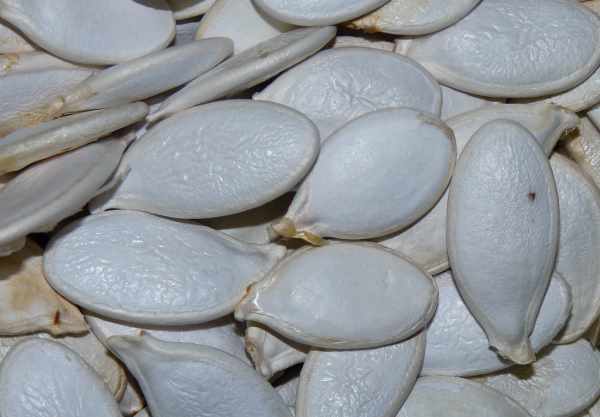

Pumpkin seed oil has anthelmintic properties, relieves constipation.
In cooking, there are many pumpkin recipes.
Many people think that the pumpkin is a rounded orange or bright yellow fruit. But this vegetable crop is diverse in its color, size, shape and fruit taste. There are also decorative and inedible varieties.
Growth rate
The yield of the crop is greatly influenced by the growth rate of the ground part and the root system of the plant. Do you want to properly organize the care of the pumpkin and create favorable conditions for its growth? Then it will be useful for you to know the following facts:
- By the time the shoots emerge, the main root grows 10–20 cm and has lateral shoots.
- The root system reaches its maximum size by the time of flowering.
- The first true leaf appears on the 5-6th day after germination. Over the next fifteen days, four more leaves are formed, then their growth slows down. At this time, the plant looks like a small bush.
- Around the 30th day after germination, the pumpkin begins to grow intensively. The total growth of all growing parts can reach several tens of meters per day.
- The timing of the appearance of the first buds and flowers depends on what the pumpkin variety and variety are. This usually occurs between 35 and 60 days after germination.
- Male flowers appear first. If the opposite happens, then artificial pollination will be required to save the crop.
- The ovary appears 3–8 days after the beginning of flowering of female flowers. And the full ripening of the fetus occurs only on the 30-60th day after their setting. The varieties of hard-bore pumpkin are considered early ripening.
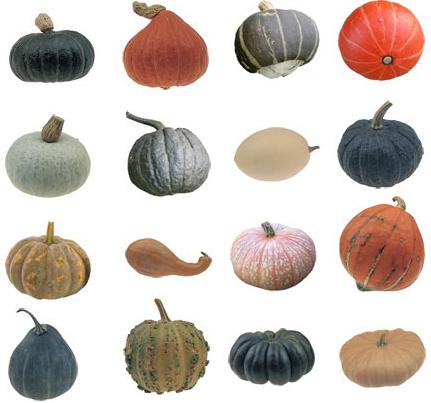

Harvesting and storage conditions for pumpkin
To prevent the pumpkin from spoiling in the garden, you need to harvest on time. The moment of ripening can be recognized by the following signs:
- The peduncle becomes rough and rough;
- Foliage and whips turn yellow and dry;
- The skin coarsens and acquires the typical pattern of the variety.
It is necessary to harvest before stable frosts. Pumpkin pruning occurs with a stalk up to 6 cm. The cut fruits are placed in a dry, warm room. For a week, the pumpkins ripen, and the stalk dries up.
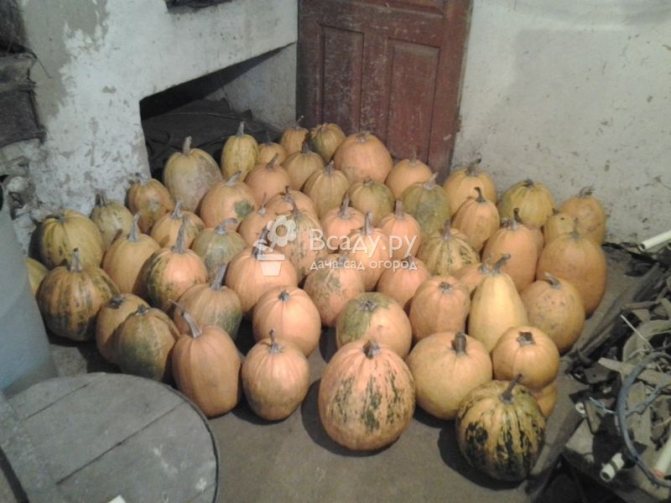

Storing pumpkin in a heated room
At the onset of frost, unripe, unpicked pumpkins are mulched with straw or agrofibre.
How to choose a pumpkin
Use the following tips to pick a ripe and healthy vegetable:
- Don't buy pumpkin that has dents or cracks. This means that the vegetable has already begun to deteriorate.
- The larger the pumpkin, the more water it contains.
- A quality product has dry seeds and a rich orange pulp.
- The stalk should be dry and the crust firm.
If you buy a vegetable from a neighbor, ask what kind it is, and make sure that the pumpkin was stored correctly.... A dark and dry room, such as a garage or cellar, is considered ideal. Inspect the product carefully, tap on it. If the sound is muffled, it means that the pumpkin is ripe and ready for use.
When to remove it and how to use it?
You need to remove the decorative pumpkin before the first frost: fruits damaged by frost will not be stored. Ripe (with a hard crust) pumpkins are dried and used for interior decoration and making crafts.
You need to remove the decorative pumpkin before the first frost.
Small fruits are usually dried whole without removing the core. In larger fruits, it is better to carefully remove the pulp and seeds by cutting out a small lid on top. Such pumpkins are used to make vases for winter arrangements, decorative boxes, candlesticks and so on.
A larger pumpkin will make a pretty vase.
To keep the fruits bright, place them indoors where the sun's rays can't reach. Ornamental pumpkin products can be painted and varnished. This is a great activity for children who will be proud of handicrafts made from their own pumpkins.
Finally, for inspiration, admire the fantastic artwork of American artist Marilyn Sunderland. It's hard to believe that all these wonders are carved from the most ordinary pumpkin, isn't it? ..
Crop rotation
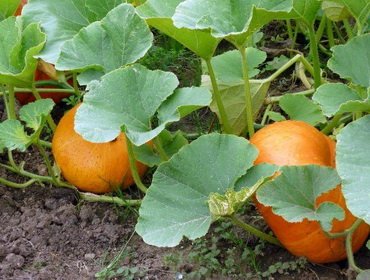

The best predecessors of the culture are legumes, onions, cabbage (early), garlic. It is not recommended to plant a pumpkin on the site of last year's crops of carrots, tomatoes and late cabbage. If in the last season young potatoes, beets, cucumbers or greens grew on the plot, this will not affect the result either in a good or in a bad way. As for the neighbors of the current season, the best of them will be beans, corn, beets and radishes. But it is better to plant it away from tomato and potato beds.
Decorative views
The main purpose of decorative greenfinches is to decorate the backyard territory.
These plants are part of landscape design and are used to decorate gazebos, fences and fences.
The fruits are usually of unusual sizes and shapes, and the bark is often decorated with stripes, shading, and specks. The crop is removed until fully ripe, dried, in order to be subsequently used as decorative elements.
Goose with apples is the most popular variety. It is not used for food purposes.
Pear-shaped fruits. Outwardly, they resemble birds with elongated necks, because have an end narrowed on one side in the form of an elongated neck.
The bark is green with light blotches of various shapes. The foliage of the plant is velvety, which makes it even more decorative. ...
Requirements for growing conditions
Pumpkin is considered an undemanding plant, however, for its proper development and obtaining high yields, a number of conditions must be met. Recommendations can be seen in the table:
| Factor | Conditions |
| Lighting | Light areas, partial shade from buildings, fences and tall plants are suitable. |
| Temperature | Optimal +25 ° С. |
| Priming | Loose, moderately moist, nutritious especially at the surface. The medium is neutral or with slight fluctuations in pH 5-8. |
| Best predecessors | Legumes, potatoes, onions, cabbage. |
It is dangerous to plant after zucchini, squash, cucumbers, watermelons, or in one place for the second season in a row due to the risk of contamination with bacteria remaining in the soil. The optimal planting time for vegetables of this family is in 3-4 years.
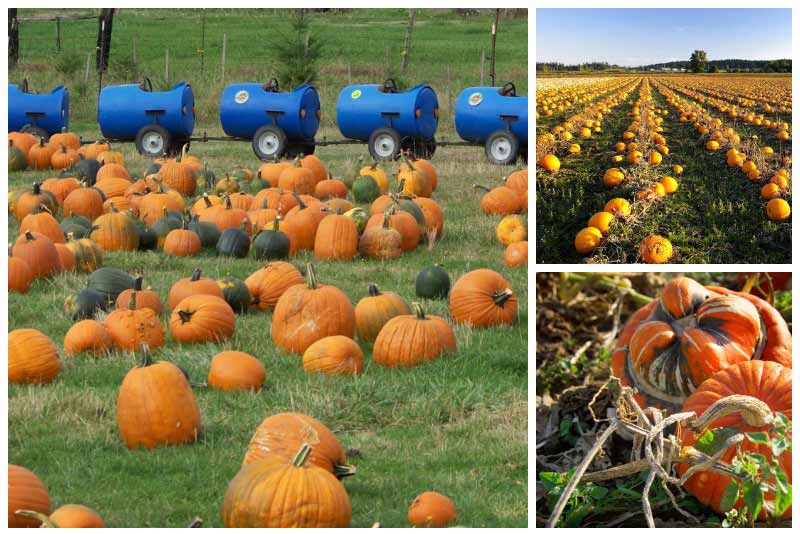

When to plant pumpkin outdoors
Pumpkin
southern melon crop which needs space when growing. Loves sunny areas with an optimal growth temperature of +25 degrees. At +14 degrees, the pumpkin stops growing.
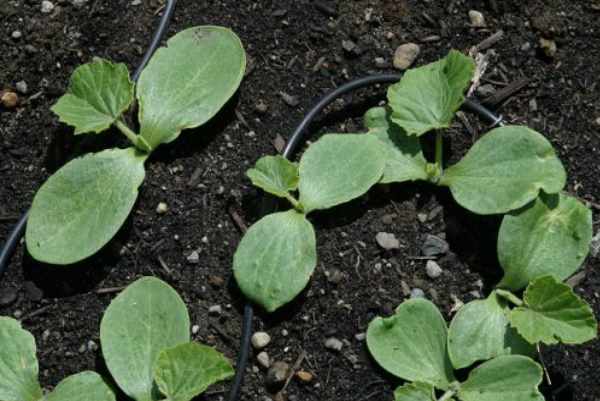

Any soil is suitable for growing pumpkin, but fertile soil is needed to produce large fruits. Apply mineral and organic fertilizers to the site.
Immediately before sowing, ash, humus, superphosphate are added to the wells. Fresh manure is very good for pumpkin.
This is sown with seeds directly into the ground or planted with seedlings.
A species such as butternut squash is grown only with seedlings.
Pumpkin grows best in areas where beets, eggplants, carrots, peppers, legumes, cabbage, potatoes, tomatoes, and onions grew before.
Areas where zucchini, cucumbers, squash grew are not suitable.
Video - Pumpkin - growing and pinching
Growing pumpkin in a seedless way
A place for planting pumpkins is chosen warm, abundantly warmed up by the sun's rays, without gusty winds, with moderate soil moisture.
To grow pumpkins in a seedless way, you need to make sure that the ground has warmed up to +13 - +15 degrees at a depth of 10-12 cm. Usually, this period falls at the beginning of May.
The site is preliminarily dug up, a complex of mineral fertilizers and humus is introduced in the fall. Before planting seeds in the soil, it is also necessary to dig up the future site.
Seed preparation
Seeds need to be selected the most beautiful, smooth, convex, without visible deformed areas and surface roughness.
Seed preparation implies their disinfection by soaking for 30 minutes in potassium permanganate (1 g. Per 100 ml.). After this procedure, the seeds are placed on a damp cloth, germinated in a warm place, moistening as needed. If desired, you can do only with a disinfecting procedure, without additional germination.
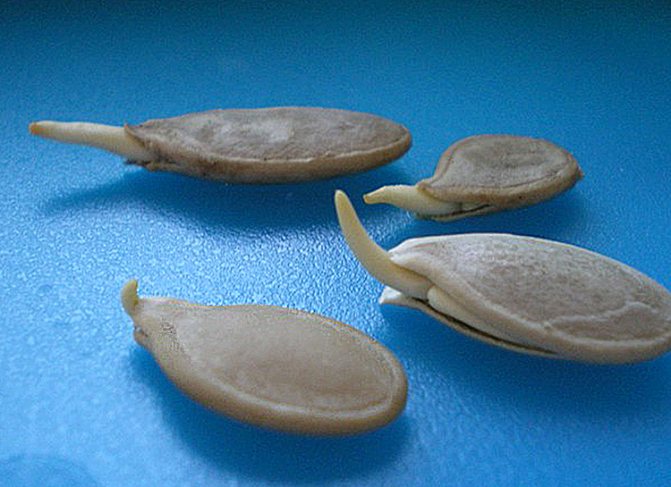

Soil preparation and planting
To prepare the ground for planting a pumpkin, you need to clear it of weeds and large stones or boulders. Prepare the soil in the fall - digging and loosening the ground.
2-3 days before planting the seeds, re-digging is carried out, with the introduction of humus. After the surface is loosened.
Small holes are dug for the pumpkin, up to 10 cm deep. Composting or humus is encouraged. After fertilization, you need to water 2 liters. warm water (50 degrees) each hole. This is necessary for additional heating of the soil. Seeds are placed in the hole in the amount of 3-4 pieces. and sprinkle with soil.
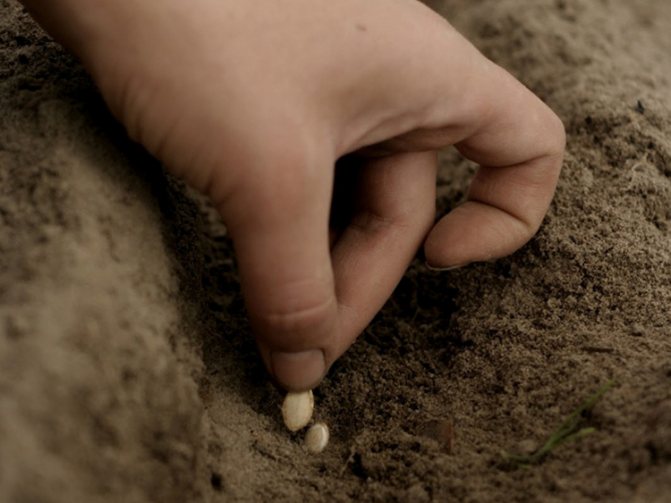

Sometimes gardeners plant seeds at different depths, this is due to the fact that they have the likelihood of unexpected drops in temperatures, or frosts. Thus, the seeds that are planted will not germinate deeply earlier, and if they die from freezing, then the seeds that are planted deeper will sprout later.
If there was no frost, the late shoots are removed.
The first shoots appear 6-7 days after planting. Depending on the quality and number of seedlings of seedlings, they must be thinned out. Rarely do all the seeds in the hole grow, but if they have sprouted all, thinning implies the removal of thinner and weaker seedlings. 1-2 of the strongest plants are left in one hole.
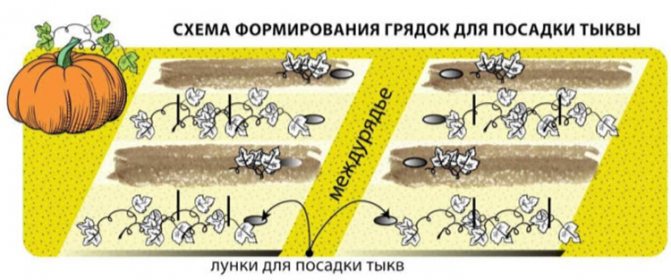

Advantages and disadvantages
The advantages of bush crop varieties include:
- compactness - this property allows you to grow a plant in small areas of open ground;
- the structure of the bush - thanks to it, moisture in the soil remains longer, which has a positive effect on productivity;
- tolerance to low temperatures;
- ease of care;
- high yields in most species;
- early and mid-ripening - in contrast to climbing varieties.
Among the disadvantages of bush pumpkin are:
- predominantly hard peel;
- not all varieties have sweetness.
This type of pumpkin is suitable for both domestic and industrial cultivation. A variety of varieties allows you to choose the best plant option.

